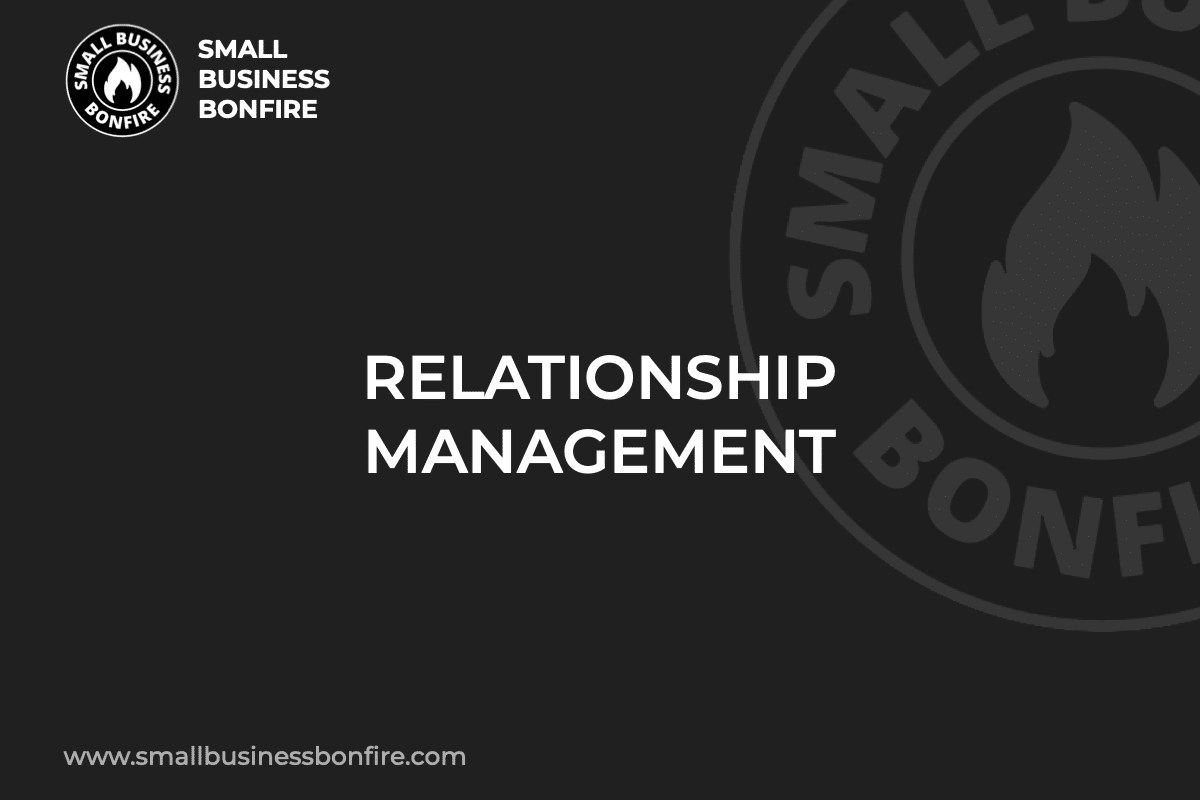Have you ever lost a valued customer and couldn’t pinpoint exactly where things went wrong?
Maybe you’ve struggled to nurture meaningful connections with your clients, or perhaps you’ve found it challenging to keep track of all client communication.
Hi, my name is AJ! I created Small Business Bonfire (SBB) after selling my company for multiple seven figures!
Through my experience, I’ve learned that relationship management is the key to long-term growth for small and medium-sized businesses (SMBs).
If you want to learn how relationship management can help grow your business, improve client relationships, and boost sales, keep reading!
I’m here to reveal everything you need to know (and more!).
Key Takeaways
- Relationship management is what a business does to create and maintain strong relationships.
- RM is beneficial because it helps retain customers and improve loyalty.
- Small companies use RM for risk management and cost-effectiveness purposes.
- Combining CRM systems with RM strategies is the best way to gather and learn about your customers.
Related Reading: Small Business CRM
SBB Featured Partners
What is Relationship Management?
Relationship management is a strategy businesses use to maintain ongoing engagement with their supply chain and customers.
What’s the point of this?
Well, companies that focus on managing relationships aim to create valuable, long-term partnerships between themselves and the entity they interact with.
Therefore, instead of viewing relationships as purely transactional, effective relationship management considers interactions as meaningful partnerships.
Companies maintain positive relationships through the following departments and actions:
- Sales strategies
- Customer service
- Customer data analysis
There are several benefits of maintaining positive relationships.
Still, the most prominent advantage is that it can boost brand loyalty!
How Does Relationship Management Work?
At its core, relationship management works by developing a deep understanding of the needs and wants of clients and stakeholders.
Businesses actively engage with the individuals and entities they serve, promoting open communication channels to gather feedback and insights.
Then, companies leverage this information to tailor products, services, and interactions to meet expectations better and enhance customer satisfaction!
Over time, this continuous effort fosters a sense of trust and loyalty, turning transient clients into long-term partners.
Types of Relationship Management
There are three main kinds of relationship management, including the following:
- Customer relationship management
- Business relationship management
- Client relationship management
Here’s what you need to know about each of these relationships!
Customer Relationship Management (CRM)
CRM is for business-to-customer (B2C) businesses.
This strategy aims to build incredible customer relationships by collecting valuable data about potential AND current buyers.
Therefore, CRM primarily relies on data and sales analysis.
Using this information, teams hope to understand the following things with CRM:
- Market trends
- Economic landscape
- Customer preferences
- Marketing techniques
- Post-sales strategies to build loyalty
CRM systems are advanced, and (almost) every business can benefit from having one!
Of course, advanced technology means it can take longer to implement into your business.
Still, investing in CRM software results in higher sales, more loyal customers, and happier employees!
Business Relationship Management
Business RM encourages productive relationships between a company and its business partners.
Also known as B2B management, these relationships occur with the following entities:
- Vendors
- Suppliers
- Distributors
- Other associates
What’s the purpose of business RM?
Companies aim to build trust and create equally beneficial rules and expectations.
That way, everyone is on the same page, and business transactions are MUCH smoother (trust me on this one)!
Client Relationship Management
Client RM is a strategy primarily designed for service-oriented businesses where individual clients and their needs are central to the operation.
This approach is about understanding the client’s specific needs and ensuring services are tailored to effectively meet those needs!
Also, client RM involves the following aspects:
- Fostering a personal relationship with clients
- Maintaining open and consistent communication
- Ensuring the client feels valued
At the end of the day, the ultimate goal is to enhance client satisfaction and promote client retention!
Why Is Relationship Management Important?
Relationship management is vital for several reasons!
First and foremost, it fosters strong, resilient bonds between businesses and their clients or partners.
Why is it critical to focus on these bonds?
When companies emphasize maintaining relationships, it increases customer loyalty and retention.
Also, RM provides businesses with valuable insights about their clients or partners, enabling them to tailor their services or products to meet their needs more effectively.
On top of that, relationship management skills can streamline communication, making business transactions smoother and more efficient.
Did you know RM can also help businesses stand out in a crowded market?
That’s right! Creating a customer-centric business gives companies that much-desired competitive edge!
Additionally, RM can lead to positive word-of-mouth referrals, expanding the business’s customer base.
Lastly, RM is critical because it sets the foundations for long-term business success, focusing on building and maintaining lasting relationships rather than short-term gains.
Why Do Small Businesses Use Relationship Management?
Are you still looking for a reason to implement RM into your business processes?
Some reasons small businesses manage relationships include the following:
- Attract more customers
- Reduce risks
- Implement more cost-effective business practices
- Build a strong brand image
- Improve team efficiency
- Create customer loyalty
Let’s look at these reasons in closer detail!
To Attract Customers
Strong relationship management skills are a dynamic tool in attracting customers by fostering an environment of trust and loyalty, which makes a business stand out!
Also, by understanding customer needs and tailoring products and services accordingly, businesses can deliver a personalized shopping experience that resonates deeply with buyers.
To Mitigate Risks
Effective RM mitigates risks by paving the way for open communication.
As a result, businesses can address and correct potential issues promptly.
Also, strong relationships built through RM contribute to stability and predictability in business operations.
Stability prevents misunderstandings and miscommunications that could lead to financial or reputational damage!
For Cost-Effectiveness
Implementing RM strategies can contribute significantly to the cost-effectiveness of a business by boosting customer retention.
When companies increase customer retention rates, it reduces the high costs associated with acquiring new customers.
Also, the insights you can gain from RM can improve your company’s products or services, reducing waste and inefficiencies!
To Build Brand Image
Through RM, businesses can craft a reliable and customer-centric image that resonates positively with their target audience.
This engagement fosters trust and loyalty and shapes the brand’s perception.
Ultimately, this enhances a company’s reputation and standing in the marketplace!
Brand image is vital, especially for consumers who have never heard of your company.
When a new customer visits your website or social media platforms, your brand images MUST reflect your mission, products, and goals!
To Improve Administrative Efficiencies
Another reason companies focus on RM so heavily?
It can streamline administrative processes, reducing errors and improving coordination among teams!
Companies can implement better organizational systems and decision-making processes by understanding internal AND external needs.
Errors can be extremely pricey, so utilizing strategies to avoid them is a must!
Establish Customer Loyalty and Trust
Businesses can consistently meet and exceed customer expectations by tailoring their products or services using RM tactics.
As a result, this fosters a sense of reliability and dependability.
Also, this continued satisfaction and personalized engagement cultivate a deep sense of loyalty and trust toward the business, securing long-term relationships with customers!
As previously mentioned, long-term customers are crucial because they’re less expensive to sell to than new buyers.
On top of that, loyal buyers can recommend your products or services to their friends and family (which is free advertising for you!).
What Does a Relationship Manager Do?
Hiring a relationship manager is excellent if RM strategies are new to you and your team!
Below, I’ve listed what relationship managers do, their salary, and what skills you must look for in a potential candidate!
Let’s take a look.
Relationship Manager Daily Tasks
A relationship manager is responsible for several daily tasks.
These tasks primarily revolve around building and maintaining positive relationships with a company’s key clients or partners.
For example, this includes the following things:
- Regular communication with individuals or entities to understand their needs
- Resolving any customer issues
- Ensuring client satisfaction with the company’s products or services
On top of that, a relationship manager tracks client interactions and feedback, using this data to evolve and improve the company’s offerings.
Further, these managers collaborate with internal teams to align client requirements and expectations with company operations!
Relationship Management Skills
A competent relationship manager has excellent communication skills, facilitating clear and compelling interactions with clients and internal teams.
Also, these managers should have the following skills:
- Problem-solving capabilities
- Networking skills
- Understanding customer service-related tasks
- A keen sense of empathy
- Organization skills
- Interpersonal skills
Put simply, you want your company’s relationship manager to be capable of talking with and forming strong connections with your clients!
This person should be a people person who is capable of talking to just about anyone.
Relationship Manager Salary
On average, relationship managers earn around $70,000 annually.
This position’s salary ranges from $50,000 to over $100,000.
What factors determine how much a relationship manager earns? Consider the following things:
- Experience in the role
- Time with the company
- Location
- Industry
- Company
- Individual skills
- Extra certifications
Relationship Management and CRM Software
Just like a good friend who always remembers your favorite ice cream flavor, customer relationship management (CRM) software is a tool that helps businesses remember essential details about their customers.
Imagine having hundreds of friends; it’s hard to remember everyone’s favorite ice cream, right?
That’s where CRM tools come in!
A CRM system keeps track of the following things:
- Customer preferences
- Purchase history
- Feedback
- Marketing campaigns
- Sales cycle statistics
- Social media conversations
- Unique pieces of customer data
Basically, CRM tools are just like a super-organized digital diary.
So, when businesses use a CRM platform, they practice relationship management more efficiently!
It’s like having a personal assistant who reminds you, “Hey, it’s John’s birthday today. He loves chocolate chip ice cream, by the way!”.
Combining a CRM system with RM helps businesses do the following things:
- Serve customers better
- Build stronger relationships
- Create an environment where customers feel valued and understood
Improving relationships is MUCH easier with CRM because the system collects and organizes more data than you can even imagine.
On top of that, many CRMs have automation abilities, allowing your employees to work on more customer-centric tasks!
How To Improve Relationship Management
If you already have an RM system in place, you might be looking for ways to improve it.
Below, I’ve listed the five-step process me and my team used to take our RM strategy to the next level!
Step 1: Identify Relationship Management Goals
Identifying relationship management goals is crucial to ensure your strategies align with your business objectives and customer needs.
By setting clear and measurable goals, you can do the following things:
- Better evaluate your progress
- Make necessary adjustments
- Drive sustained growth in your business relationship
Step 2: Examine Current Relationship Management Practices
Reviewing current RM practices involves critically examining your existing strategies and tactics and evaluating their efficiency and effectiveness.
As you examine these tactics, you should do the following things:
- Assess how current operations align with customer expectations
- Identify areas of strength
- Pinpoint opportunities for improvement in your client relationships
Step 3: Identify Opportunities to Improve Relationship Management
Identifying opportunities for improvement in relationship management is pivotal for business growth and customer satisfaction.
For instance, these opportunities often reveal gaps and inefficiencies in your current strategies.
When you’re aware of what’s NOT working, your business can refine its strategies and deliver more value to its customers.
Further, by consistently seeking improvements, businesses can do the following things:
- Stay ahead of the competition
- Foster stronger relationships
- Enhance the company’s bottom line
Step 4: Create a CRM Strategy
Creating a CRM strategy is integral to advancing your RM efforts.
Businesses can centralize customer data by leveraging a CRM system, ensuring all key interactions, preferences, and feedback are stored in one place!
Why are CRM tools so helpful?
CRM software can do the following things:
- Facilitate personalized engagement
- Strengthen customer relationships
- Drive customer loyalty
- Boost sales
- Help companies implement more effective marketing tactics
- Stay updated with industry trends
Ultimately, a well-structured CRM strategy can significantly enhance customer satisfaction rates and boost business growth!
Step 5: Monitor and Tweak Your Relationship Management Plan
Monitoring and adjusting your relationship management plan is an ongoing, dynamic process fundamental to your business’s success.
Regular monitoring allows you to assess the efficacy of your RM strategies.
Also, by keeping up to date with your strategy, you can get insights into what’s working and where improvements are needed.
By consistently evaluating your RM practices, your business can adapt swiftly to customer needs or market conditions, ensuring you stay ahead in a competitive landscape!
Further, regular tweaks foster continuous improvement, enhancing the quality of customer relationships.
Therefore, a vigilant and proactive approach to tweaking your RM plan is indispensable to effective relationship management!
Examples of Relationship Management
Here are three examples of RM in the real world!
Take these examples as ways to improve your business or foster ideas unique to your RM strategy!
Example 1: Apple Inc.
Apple Inc. is a prime example of effective relationship management.
Apple has mastered cultivating customer relationships through excellent customer service and a loyalty program.
Further, this company has established a strong brand loyalty that customers often wait in line for hours to purchase the latest Apple product!
This loyalty is partly due to the company’s consistent delivery of high-quality products and effective use of CRM tools to understand and fulfill customer preferences.
Example 2: Amazon
Amazon is another excellent example of successful relationship management.
Amazon’s personalized recommendations based on past purchases and browsing behavior are an application of CRM tools that enhance the customer experience.
In addition, Amazon’s customer-centric approach, rapid response times, and ease of the return process significantly contribute to building and maintaining strong customer relationships.
Example 3: Starbucks
Starbucks also utilizes effective relationship management strategies.
Their popular loyalty program, Starbucks Rewards, offers frequent customers free drinks and other benefits.
These loyalty programs encourage repeat business and enable Starbucks to gather data on customer purchasing habits, which in turn helps the company customize individual customer experiences.
By integrating CRM strategy with its personalized marketing efforts, Starbucks has successfully managed and enhanced customer relationships!
Closing Thoughts on Relationship Management
At this point, you understand why building relationships is so crucial for the life of your business.
Not only do excellent relationships with customers lead to higher retention rates, but they also contribute to higher sales!
Remember, the main detail that contributes to strong relationships with potential and existing clients is data.
What strategies will YOUR company use to collect and organize customer data? Let us know in the comments section!
Newsletter Signup
Join The Leads Field Guide Newsletter for tips, strategies and (free) resources for growing your leads, and closing more deals.




